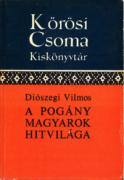A pogány magyarok hitvilága

Among the major scholars of shamanism, Vilmos Diószegi (1923-1972), whose ethnographic expeditions in the most remote regions of north-eastern Asia gave a fundamental contribution to the study of the Siberian peoples, nevertheless dedicated some important treatises to the survivals of the religion pre-Christian history of the ancient Magyars, preserved in Hungarian folklore and popular beliefs.
In this A pogány magyarok hitvilága (1967), a detailed comparative examination of the worldview of the pagan Magyars, Diószegi highlights the elements of continuity between the figures of seer, necromancer and wise man (táltos, garabonciás diák and tudós) that populate folklore Hungarian and those of the shamans well known to the traditions of the Uralic and Altaic peoples.
Drawing on a broad spectrum of comparative material, consisting mainly of fairy tales, stories and popular songs recorded from the voice of the people, Diószegi reconstructs the worldview of the ancient Magyars. He reveals the cosmological system starting from the data provided by the journeys of the fairy-tale heroes, or of the táltosok themselves, in the upper world (felső világ) and lower world (alsó világ), carried out by climbing the cosmic tree (világfa). But in particular, the figure of the táltos, his birth with a greater number of teeth, the initiation through "lasting sleep" and dismemberment, the climbing of the tree that touches the sky and the obtaining of the drum-mount, his headdress equipped with horns or feathers, the carrying out of his activity in a state of "hiding", as well as his dual soul and his mysterious song, find a precise counterpart in the shamanic tradition of the peoples of northern Eurasia. These figures therefore constitute survivals of the pre-Christian Magyar culture at the time of their arrival in the Carpathian basin, at the end of the 9th century.
This work constitutes a scientific cornerstone in the examination of magic workers in the Hungarian tradition, so much so that it can still be considered unsurpassed in terms of the amount of ethnographic material and the thoughtful care in drawing parallels with shamanism, of which Diószegi was one of the greatest experts.